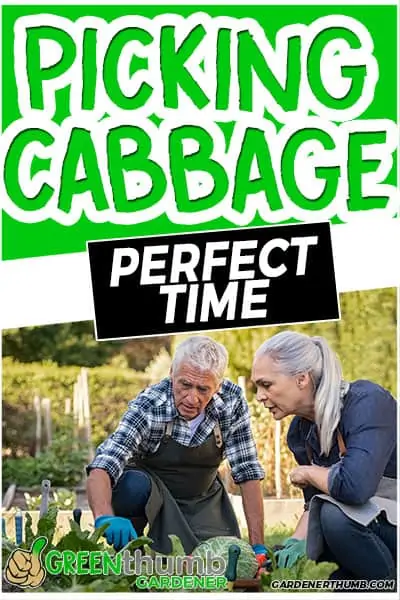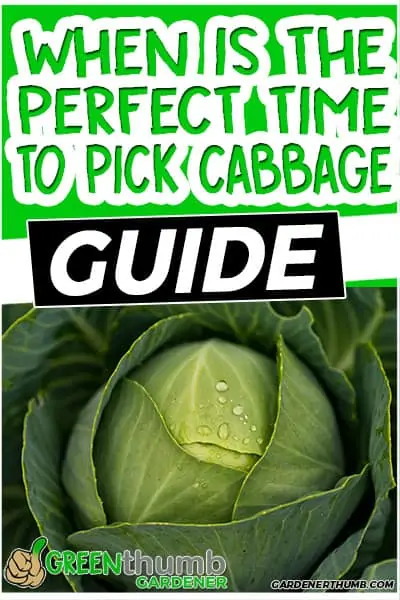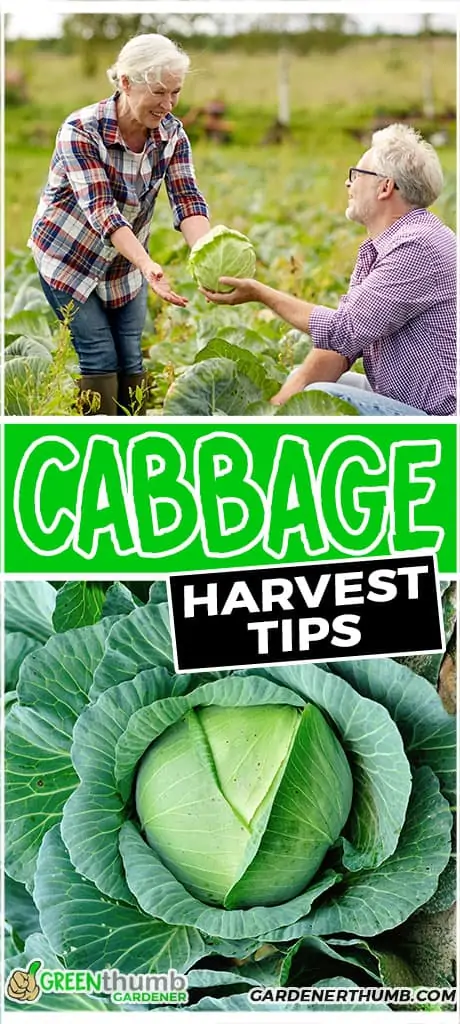Tips On When To Pick Cabbage
Last updated: 06/02/21
The cabbage plant is a very versatile and familiar-kitchen-garden vegetable that can be used in many ways. There are various varieties of cabbage available for veggie lovers that can be eaten raw, cooked solo, or mixed with other vegetables.
A fresh cabbage head is a great sight to see with its layers of fresh leaves and variety of colors. It is important to know when is the right time to pick the mature head so that you can maximize its taste and nutritional value.
Green thumb Gardener occasionally links to product and/or services offered by vendors to assist you with all your gardening needs. Some of these may be affiliate links, meaning we earn a small commission if items are purchased.
Want to Download a Garden Hack Guide for FREE

Enter your email below and we will send you a guide to help you SAVE money in your garden.
Growing Cabbage & Planting Times
Growing heads of cabbage can be a little tricky for beginner gardeners. Unlike other garden vegetables, a cabbage requires the right conditions to grow properly.
It can only grow well in cool weather, and it sometimes attracts different types of cabbage pests.
But it is all worth the effort since cabbage are packed with nutrients, helps lower cholesterol and helps improve digestion. They are also great ingredient for delicious meals like the chicken cabbage stir-fry and many other recipes.
When to Plant Cabbage
Since cabbage grows in cold weather, they are often planted just after frost in spring and to be harvested before the summer heat sets in.
They can also be planted around mid to late summer, just in time for autumn and winter harvest.

How to Plant Cabbage
It is crucial to prepare the soil before planting your cabbage seed. Cabbage plants are heavy eaters, so they need a lot of nutrients from the ground.
You can enrich the soil by mixing compost or aged manure a few days before planting. When the soil is ready, you can do the following steps:
- Cabbage grows best in well-drained soil rich in organic matter. You can place 2-3 inches (7.62 cm) of compost before planting and turn them up to 12 inches (30.48 cm) deep
- Start to sow the seed indoors around 4 to 6 weeks before the end of spring frost. Sow the seeds at least 1/2 inch (5.08 cm) deep into the ground.
- Wait until the cabbage seedlings are 3 to 4 inches (10.16 cm) tall
- Transfer the cabbage transplant outdoors 2-3 weeks before the end of spring frost
- Make sure there is enough space between the seedlings. Plant them 12 to 24 inches (0.61 m) apart, depending on the cabbage head size that you want to grow
- Do not plant the cabbage closer to each other so that it will not affect the cabbage head formation. Maximize the garden space and follow the proper spacing
How to Grow Cabbage
- Cabbage are cool weather crops that grow well in temperatures of 60 to 65° F, so it would be best to mulch the area to regulate soil temperature and retain soil moisture
- After transplanting the seedlings, wait until they are 5 inches (12.7 cm) tall before thinning them. You can gently pool the seedlings and transfer them to another location
- Do not forget to water your cabbage crop at least 2 inches (5.08 cm) of water per square foot a week
- Feed cabbage with a balanced (10-10-10) fertilizer two weeks after transplanting
- Then after three weeks, add a more nitrogen-rich fertilizer because the cabbage needs a steady supply of nitrogen in its early stages of growth
- Watch for common cabbage diseases until you are ready for cabbage harvesting
When to Harvest CabbageStep By Step Compost Guide
The timing of harvest is very critical for cabbage. If you harvest the cabbage head too fast or too late, it may affect the cabbage’s quality and nutritional value. The right time will depend on the variety of cabbage you planted.
Some cabbage varieties have a narrow window for harvest, while others can go several weeks without visible quality deterioration.
You cannot tell whether common cabbage varieties are ready for harvest simply by looking at the size of their heads because they vary from plant to plant.

You should always check the seed packet to tell you when the variety you used will become mature. But, the best way to know if the cabbage is ready for harvest is to check for the firmness of the cabbage head.
The cabbage head is ready for harvest if they are firm all the way when squeezed. The size of the cabbage heads will depend on the cabbage variety and the weather conditions in your garden.
Harvesting Cabbage Tips
When harvesting your cabbage head, you can follow the following steps and tips:
- Check the cabbage crop and look for matured heads by checking their firmness.
- Using a knife, cut from the base of the cabbage head but make sure you leave the outer leaves on the stalk so the sides head can grow.
- These side heads can grow and can still be harvested.
- An expert cabbage picker can harvest the heads by pulling and twisting them with two hands until they snap off from the stalk.
- Take care of the harvested heads and placed them away from direct sunlight while waiting for the other heads to be harvested.
- When you are done harvesting the heads, you can pull out the entire cabbage plant and place them in the compost pile. Make sure to remove parts that have traces of disease or maggot infestation.
- Before storing the heads in the refrigerator, make sure they are dry and wrapped in plastic. They can be stores for up to two weeks in the fridge.
Cabbage Storage & Preservation Tips
Please make sure the cabbage heads are dry before storing them. You can wrap them loosely in plastic and keep them in the crisper drawer. The refrigerated cabbage can last for up to two months.
If you want to store it longer, you can freeze the cabbage. Cut the heads into wedges and then blanch them in boiling water for 90 seconds.
You have to immerse the wedges in ice water immediately. Wait until they are dry and placed them in a freezer-safe bag. The frozen cabbage will last up to nine months.
You can also ferment cabbage or make homemade Sauerkraut. They are a great topping to salads, sandwiches and hot dogs.
Check out some of our tips for food preservation here.
Final Thoughts
There are many cabbage varieties you can choose from depending on the season, for example there are early-season green cabbage or early-season red cabbage.
But whatever the variety you choose your assured of a bountiful cabbage harvest especially if you follow the tips given on this article.
Does cabbage grow back after you pick it?
Yes, cabbage grow back after they are picked. But make sure you leave the outer leaves when you cut the cabbage head. They can grow new cabbage heads the size of tennis balls which are great. for salads.
How long can you leave cabbage in the ground?
Uncooked cabbage left on the kitchen countertops or table can last a week or more depending on the climate. But if place them in a refrigerator they can last 1 to 2 months in the refrigerator.
Can I pick cabbage leaves?
Yes, all you need to do is cut the cabbage head at the base of the stalk. You can also hold it with two hands and the twist and pull to pick the cabbage heads.









